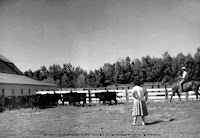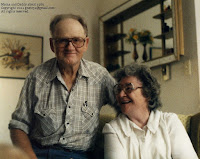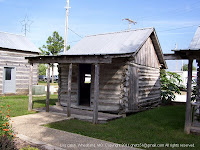Old-time log houses
On the public square at the center of
Wheatland, Missouri, a miniature village of genuine log houses awaits tourists. I call them "genuine log houses" because local residents of earlier times built and used them. The cabins were collected from Hickory County, Missouri, and the surrounding area.
My sister Charlotte has lived in the Wheatland area for over 35 years. I took these photos when we visited there a couple of years ago. Charlotte said that the original plan was to rent the log houses as shops for artists and craftspeople. That hasn't worked out as well as the town's leaders hoped, but the log cabins are interesting, nonetheless.
Charlotte said the fellow sitting on the porch at right is a retired fellow who volunteers at the log village on most summer Saturdays. He told us how the cabins were torn down and reassembled, Each log was numbered so the cabins were put back together as originally constructed. In the interest of weather-tightness, concrete chinking was used, and metal roofs and new windows were installed.
The photo at right above shows a "double pen" log house. The two log rooms were individual structures, connected only by the roof that covered them both.
The log structure in the photo above was the Butterfield Overland Relay Station along the
Butterfield Trail in Hickory County. The Butterfield Trail ran from Missouri to San Francisco, and was named for John Butterfield who founded the Butterfield Overland Mail Company. Behind the station is a barn with round, unchinked logs.
The logs of most of the structures were shaped with axes and other hand-tools. The building of log houses -- or any log structures! -- required a tremendous investment of hard labor.
This house had a sign that said "1850s Museum". We went inside to take a look.
Feather tick and an old image
I don't know if either of the stoves above are of 1850s vintage, but they are oldies for sure. Apparently the legs of the big cookstove were bad, so it is sitting on some blocks of wood.
The
Royal Princess stove at right would have had a stovepipe connected at the raised hole at the back of the top. In front of the stove pipe, you could set a tea-kettle on the flat area. The stove could be loaded through either the front door or the side door. I think maybe the shelf at right was where you set the bucket or pan when you were shoveling out the ashes. That would have made dangerous spills of hot coals onto the wood floor less likely.
Wheatland is a very small town in southwest Missouri, about 50 miles north of Springfield. Its largest industry is the
Lucas Oil Speedway which brings quite a few people to town during race season and makes a lot of noise on race nights. If the logs in these old houses could talk, they'd probably say that they're amazed, simply amazed, at the modern-day happenings in Wheatland.





















